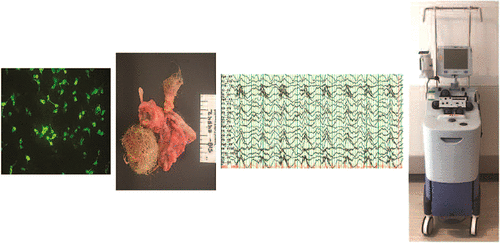当前位置:
X-MOL 学术
›
ACS Chem. Neurosci.
›
论文详情
Our official English website, www.x-mol.net, welcomes your
feedback! (Note: you will need to create a separate account there.)
N-Methyl-d-aspartate Receptor Antibody Encephalitis: A Concise Review of the Disorder, Diagnosis, and Management.
ACS Chemical Neuroscience ( IF 4.1 ) Pub Date : 2018-08-31 , DOI: 10.1021/acschemneuro.8b00304 Elizabeth M Staley 1 , Rabia Jamy 2 , Allan Q Phan 3 , David A Figge 4 , Huy P Pham 5
ACS Chemical Neuroscience ( IF 4.1 ) Pub Date : 2018-08-31 , DOI: 10.1021/acschemneuro.8b00304 Elizabeth M Staley 1 , Rabia Jamy 2 , Allan Q Phan 3 , David A Figge 4 , Huy P Pham 5
Affiliation

|
Anti-NMDA ( N-methyl-d-aspartate) receptor (anti-NMDAR) encephalitis is one of the most common paraneoplastic encephalitides. It occurs in both sexes, across all age ranges, and may occur in the presence or absence of an associated tumor. Its pathogenesis and clinical presentation relate to the presence of IgG1 or IgG3 antibodies targeting the NR1 subunit of the NMDA receptor, leading to a disinhibition of neuronal excitatory pathways. Initial clinical manifestations may be nonspecific, resembling a viral-like illness; however, with disease progression, symptoms can become quite severe, including prominent psychiatric features, cognitive problems, motor dysfunction, and autonomic instability. Anti-NMDAR encephalitis may even result in death in severe untreated cases. Diagnosis can be challenging, given that initial laboratory and radiographic results are typically nonspecific. The majority of patients respond to first or second-line treatments, although therapeutic options remain limited, usually consisting of tumor removal (if there is confirmation of an underlying malignancy) in conjunction with prompt initiation of immunosuppressive medications along with intravenous immunoglobulins and/or plasma exchange. Although the clinical presentation of anti-NMDAR encephalitis overlaps with several other more common neurological and psychiatric disorders, early diagnosis and treatment is essential for a positive prognosis. Here, we concisely review the pathogenesis, diagnosis, and clinical management of this disease.
中文翻译:

N-甲基-d-天冬氨酸受体抗体脑炎:疾病,诊断和管理的简要审查。
抗NMDA(N-甲基-d-天冬氨酸)受体(抗NMDAR)脑炎是最常见的副肿瘤性脑炎之一。它在所有年龄段的男女中均发生,并且可能在存在或不存在相关肿瘤的情况下发生。其发病机理和临床表现与靶向NMDA受体NR1亚基的IgG1或IgG3抗体的存在有关,导致神经元兴奋性途径的抑制。最初的临床表现可能是非特异性的,类似于病毒样疾病。但是,随着疾病的发展,症状可能会变得非常严重,包括明显的精神病学特征,认知问题,运动功能障碍和自主神经不稳定。在严重的未经治疗的病例中,抗NMDAR脑炎甚至可能导致死亡。诊断可能具有挑战性,鉴于最初的实验室检查和射线照相结果通常是非特异性的。大多数患者对一线或二线治疗有反应,尽管治疗选择仍然有限,通常包括切除肿瘤(如果确认潜在的恶性肿瘤)以及迅速开始使用免疫抑制药物以及静脉内免疫球蛋白和/或血浆交换。尽管抗NMDAR脑炎的临床表现与其他几种较常见的神经和精神疾病重叠,但早期诊断和治疗对于阳性预后至关重要。在这里,我们简要回顾该疾病的发病机制,诊断和临床管理。尽管治疗选择仍然有限,但通常包括切除肿瘤(如果确认潜在的恶性肿瘤)以及迅速开始使用免疫抑制药物以及静脉内免疫球蛋白和/或血浆置换。尽管抗NMDAR脑炎的临床表现与其他几种较常见的神经和精神疾病重叠,但早期诊断和治疗对于阳性预后至关重要。在这里,我们简要回顾该疾病的发病机制,诊断和临床管理。尽管治疗选择仍然有限,但通常包括切除肿瘤(如果确认潜在的恶性肿瘤)以及迅速开始使用免疫抑制药物以及静脉内免疫球蛋白和/或血浆置换。尽管抗NMDAR脑炎的临床表现与其他几种较常见的神经和精神疾病重叠,但早期诊断和治疗对于阳性预后至关重要。在这里,我们简要回顾该疾病的发病机制,诊断和临床管理。尽管抗NMDAR脑炎的临床表现与其他几种较常见的神经和精神疾病重叠,但早期诊断和治疗对于阳性预后至关重要。在这里,我们简要回顾该疾病的发病机制,诊断和临床管理。尽管抗NMDAR脑炎的临床表现与其他几种较常见的神经和精神疾病重叠,但早期诊断和治疗对于阳性预后至关重要。在这里,我们简要回顾该疾病的发病机制,诊断和临床管理。
更新日期:2018-08-22
中文翻译:

N-甲基-d-天冬氨酸受体抗体脑炎:疾病,诊断和管理的简要审查。
抗NMDA(N-甲基-d-天冬氨酸)受体(抗NMDAR)脑炎是最常见的副肿瘤性脑炎之一。它在所有年龄段的男女中均发生,并且可能在存在或不存在相关肿瘤的情况下发生。其发病机理和临床表现与靶向NMDA受体NR1亚基的IgG1或IgG3抗体的存在有关,导致神经元兴奋性途径的抑制。最初的临床表现可能是非特异性的,类似于病毒样疾病。但是,随着疾病的发展,症状可能会变得非常严重,包括明显的精神病学特征,认知问题,运动功能障碍和自主神经不稳定。在严重的未经治疗的病例中,抗NMDAR脑炎甚至可能导致死亡。诊断可能具有挑战性,鉴于最初的实验室检查和射线照相结果通常是非特异性的。大多数患者对一线或二线治疗有反应,尽管治疗选择仍然有限,通常包括切除肿瘤(如果确认潜在的恶性肿瘤)以及迅速开始使用免疫抑制药物以及静脉内免疫球蛋白和/或血浆交换。尽管抗NMDAR脑炎的临床表现与其他几种较常见的神经和精神疾病重叠,但早期诊断和治疗对于阳性预后至关重要。在这里,我们简要回顾该疾病的发病机制,诊断和临床管理。尽管治疗选择仍然有限,但通常包括切除肿瘤(如果确认潜在的恶性肿瘤)以及迅速开始使用免疫抑制药物以及静脉内免疫球蛋白和/或血浆置换。尽管抗NMDAR脑炎的临床表现与其他几种较常见的神经和精神疾病重叠,但早期诊断和治疗对于阳性预后至关重要。在这里,我们简要回顾该疾病的发病机制,诊断和临床管理。尽管治疗选择仍然有限,但通常包括切除肿瘤(如果确认潜在的恶性肿瘤)以及迅速开始使用免疫抑制药物以及静脉内免疫球蛋白和/或血浆置换。尽管抗NMDAR脑炎的临床表现与其他几种较常见的神经和精神疾病重叠,但早期诊断和治疗对于阳性预后至关重要。在这里,我们简要回顾该疾病的发病机制,诊断和临床管理。尽管抗NMDAR脑炎的临床表现与其他几种较常见的神经和精神疾病重叠,但早期诊断和治疗对于阳性预后至关重要。在这里,我们简要回顾该疾病的发病机制,诊断和临床管理。尽管抗NMDAR脑炎的临床表现与其他几种较常见的神经和精神疾病重叠,但早期诊断和治疗对于阳性预后至关重要。在这里,我们简要回顾该疾病的发病机制,诊断和临床管理。











































 京公网安备 11010802027423号
京公网安备 11010802027423号